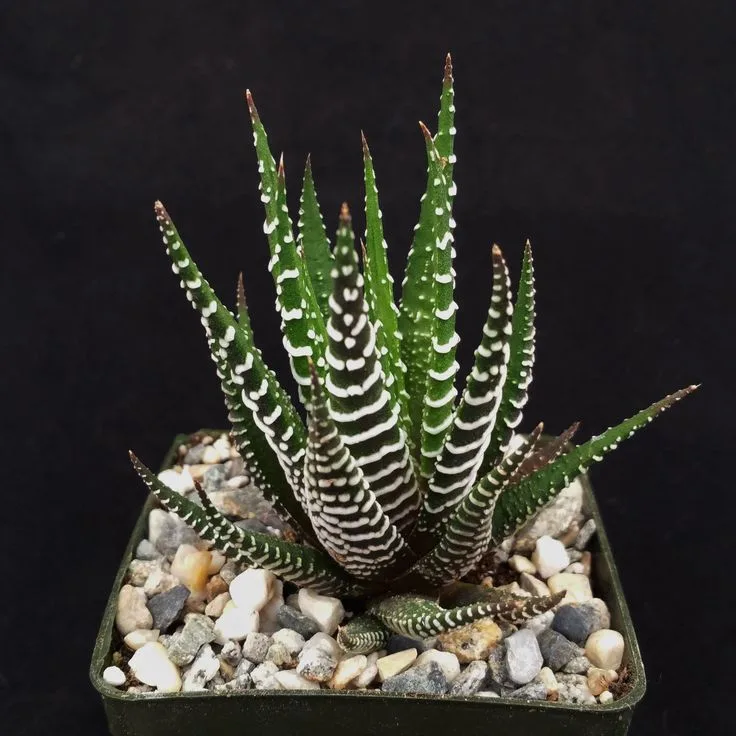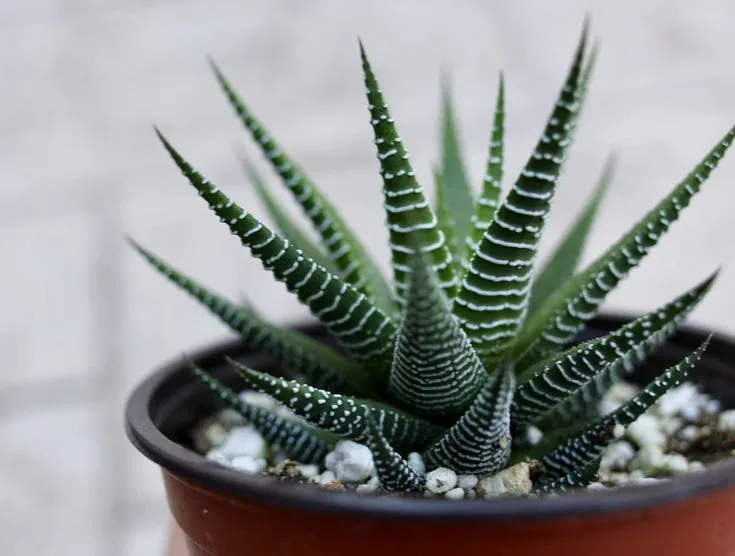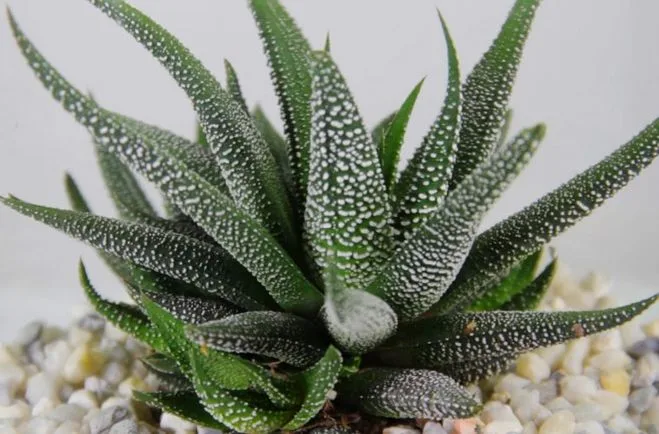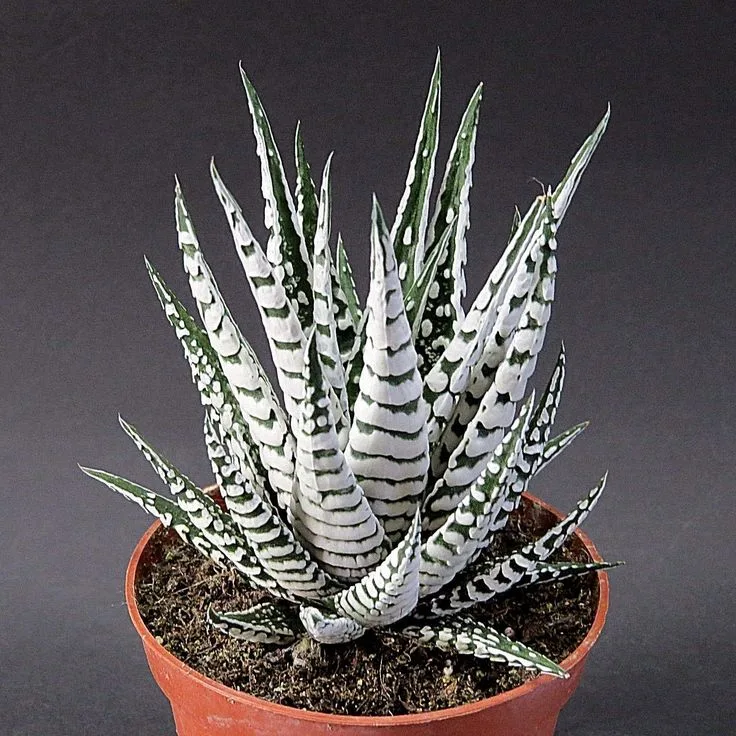Index
Presentation
If you’re looking for a succulent plant that combines beauty and practicality, Haworthia Fasciata is an exceptional choice. Originally from South Africa, this little wonder belongs to the Asphodelaceae family and is known for its distinctive patterns and fleshy leaves that make it a charming addition to any plant collection.
Meaning of Haworthia Fasciata
In addition to its impressive aesthetics, Haworthia Fasciata carries with it a symbolic meaning. Traditionally associated with resistance and resilience, its succulent leaves represent the ability to thrive even in the most challenging conditions. Growing this plant in your garden is not only an aesthetic decision, but also a constant reminder of the strength that can be found in nature’s simplicity and adaptability. Try bringing Haworthia Fasciata into your space and discover how this little wonder can brighten not only your garden, but also your spirit.
| Common Name | Haworthia Fasciata |
| Botanical Name | Haworthia Fasciata |
| Family | Asphodelaceae |
| Plant Type | Succulent |
| Adult Size | Small |
| Sun Exposure | Indirect light in full sun |
| Soil Type | Well-drained |
| soil pH | Neutral to Slightly Acidic |
| Flowering Season | Spring |
| Flower Color | White or light green |
| Native Area | South Africa |
| Toxicity | Not Toxic |

How to Care for Haworthia Fasciata
When growing Haworthia Fasciata, it is crucial to provide proper care to ensure its healthy flowering. Below are detailed guidelines on how to care for this unique succulent.
Light: Finding the Perfect Balance
Haworthia fasciata appreciates light, but direct exposure to intense sunlight can be harmful. Prefer locations with indirect light to full sun. If you’re indoors, a window with filtered light is ideal. Avoid long hours in direct sunlight, especially at the hottest times of the day.
Soil: Drainage is key
These succulents thrive in well-drained soil. Use a specific mix for succulents or cacti, ensuring that water is not trapped in the roots. Haworthia fasciata prefers slightly acidic to neutral soil, providing an environment conducive to its development.
Water: moderation is key
Haworthia Fasciata should be watered sparingly. Let the soil dry out completely between waterings. Avoid excess moisture, as the accumulation of water in the roots can lead to rotting. During the colder months, reduce the frequency of watering even more.
Temperature and Humidity: Comfortable Environment
These succulents are adaptable to a variety of temperatures, but prefer moderate environments. Keep them at temperatures between 18°C and 24°C. Moderate humidity is sufficient, making them ideal for ordinary indoor environments.
Fertilizing: Nutrients in the Right Measure
Fertilize Haworthia Fasciata during spring and summer, when it is actively growing. Use a diluted balanced fertilizer and apply it sparingly. Avoid fertilizing during dormant periods or when the soil is dry, as this can harm the plant.
By following these care guidelines, you’ll be on the right track to keeping your Haworthia Fasciata healthy and lush. Always remember to observe the plant ‘s specific needs and adjust care as necessary.

How to Make Haworthia Fasciata Cuttings
If you want to multiply the presence of the elegant Haworthia Fasciata in your garden, propagating cuttings is a rewarding way to do it. Follow our step-by-step instructions to ensure a successful process.
How to Make Cuttings: Simple Steps to Success
- Choosing the Mother Plant: Select a healthy, mature plant as the mother plant. Make sure it is free of diseases and pests.
- Preparing the Soil: Use a well-aerated and drainable substrate for succulents. This is crucial for the development of the seedling’s roots.
- Removing the cutting: Carefully remove a healthy leaf from the mother plant. Make sure to include part of the stem to ensure a better rooting success rate.
- Drying the cutting: Allow the cutting to air dry for 1 to 2 days. This helps to form a protective shell at the base of the leaf.
- Planting: Plant the cutting in prepared soil, lightly burying the base of the leaf in the soil. Avoid burying too deeply.
- Moderate watering: After planting, water lightly to moisten the soil. Avoid over-saturation.
- Additional Care: Place the seedling in indirect light until the roots develop. After rooting, transfer to the desired location.
How to plant Haworthia Fasciata
- Site selection: Plant the seedling in a spot with adequate light, following the growing guidelines for adult plants.
- Controlled watering: Keep watering controlled to avoid excess humidity. Seedlings are more sensitive to humid conditions than mature plants.
- Growth monitoring: Monitor the growth of the seedling regularly. Once established, Haworthia Fasciata will follow the general care guidelines for adult plants.
By following these simple steps, you’ll be growing healthy Haworthia Fasciata seedlings and expanding your collection in a rewarding way. Remember to be patient and careful throughout the process.
Pests and Diseases in Haworthia Fasciata
When growing the lovely Haworthia Fasciata, it’s important to be aware of the possible pests and diseases that can affect this succulent. Here are some of the most common threats, accompanied by effective solutions to keep your plant healthy and vibrant.
Most Common Pests and Diseases: A Detailed List
- Mites: Mites can appear as small dots on the plant. Use a spray of water to remove them or resort to essential oils, such as neem, for control.
- Mealybugs: These sap-sucking insects leave white spots on the plant. Remove them by hand or use a mild soap and water solution to clean them.
- Root rot: Excess moisture can lead to root rot. Reduce watering, ensure well-drained soil and adjust the environment to avoid excessively humid conditions.
- Leaf spots: Dark spots on the leaves can indicate excess moisture. Adjust watering practices and provide good air circulation.
Common Problems and Their Solutions: Keeping Your Plant Healthy
- Wilted leaves: If the leaves are wilted, check the amount of water supplied. Adjust watering as necessary, avoiding both too much and too little.
- Yellowing leaves: Yellowing leaves may indicate too much sun. Move the plant to a location with more diffused light.
- Slow growth: Slow growth can be the result of a lack of nutrients. Fertilize the plant during the growing season with a balanced fertilizer.
- Changesin flower color: Changes in flower color can be influenced by the intensity of the light. Adjust the sun exposure to maintain the desired color.
By paying attention to these signs and applying the right solutions, you can overcome the common challenges in growing Haworthia Fasciata, keeping it lush and problem-free.

Curiosities and Myths
Discover the fascinating facts and dispel the myths surrounding Haworthia Fasciata. Knowing more about this unique succulent can deepen your appreciation for this botanical gem.
Surprising facts about Haworthia Fasciata
- Resistance to stress: Haworthia Fasciata is known for its remarkable resistance to environmental stress. Its fleshy leaves have the ability to store water, allowing the plant to survive in the harshest conditions.
- Variety of Patterns: One of the distinctive features of this succulent is its unique leaf patterns. From zigzagging lines to speckled dots, the variety of patterns adds an artistic touch to the plant.
- Botanical kinship: Haworthia Fasciata belongs to the same family as the well-known genus Aloe, sharing some common characteristics with the popular aloe vera succulents.
Dispelling Common Myths about Haworthia Fasciata
- Root size: A common myth is that the roots of Haworthia Fasciata are invasive. In reality, its roots are quite compact, making it an excellent choice for small spaces and growing in pots.
- Fast-growing: Contrary to myth, Haworthia Fasciata is known for its slow and steady growth. This contributes to its easy maintenance and makes it a great choice for those looking for a plant with controlled growth.
- Extreme light requirements: Although it appreciates light, the myth that Haworthia Fasciata requires intense sun exposure is mistaken. It thrives best in indirect light to moderate full sun.
Exploring these curiosities and dispelling myths provides a broader perspective on Haworthia Fasciata, highlighting its uniqueness and adaptability. By better understanding this succulent, you’ll be better prepared to create an ideal environment for its healthy growth.

Conclusion
By exploring the universe of Haworthia Fasciata, we have discovered a remarkable succulent that goes beyond its aesthetic beauty . Originally from South Africa, this plant reveals exceptional resilience and a unique ability to adapt to different environments. From its intricate patterns to its ability to store water in its fleshy leaves, Haworthia Fasciata is a true botanical gem.
We understand the importance of specific care, from exposure to light to moderate watering, to ensure the healthy flowering of this succulent. We explore fascinating curiosities, such as its botanical kinship with the genus Aloe, and unravel common myths surrounding its cultivation. In the end, we realized that Haworthia Fasciata is not just a plant, but a resilient companion that can thrive with the right attention. By integrating this knowledge into our care, we can cultivate and enjoy the lasting beauty of this unique succulent in our green spaces.
Frequently Asked Questions
What are the types of haworthia?
There are several types of Haworthia, each with unique characteristics. Some examples include Haworthia attenuata, recognized for its translucent rosette-shaped leaves, and Haworthia cooperi, known for its fleshy leaves and attractive patterns. Exploring the variety of these succulents allows you to create diverse collections, enriching the garden with their distinctive shapes and patterns.
How to care for a haworthia fasciata?
To care for a Haworthia Fasciata, attention to specific details is essential. Provide indirect light to moderate full sun, use well-drained soil and water sparingly, avoiding excessive water accumulation. Control the temperature, keeping it between 18°C and 24°C, and ensure moderate humidity. Fertilize during spring and summer with a balanced fertilizer. Keep an eye out for common signs, adjusting care as necessary. With these practices, your Haworthia Fasciata will thrive, showing off its unique beauty and remarkable resistance.







